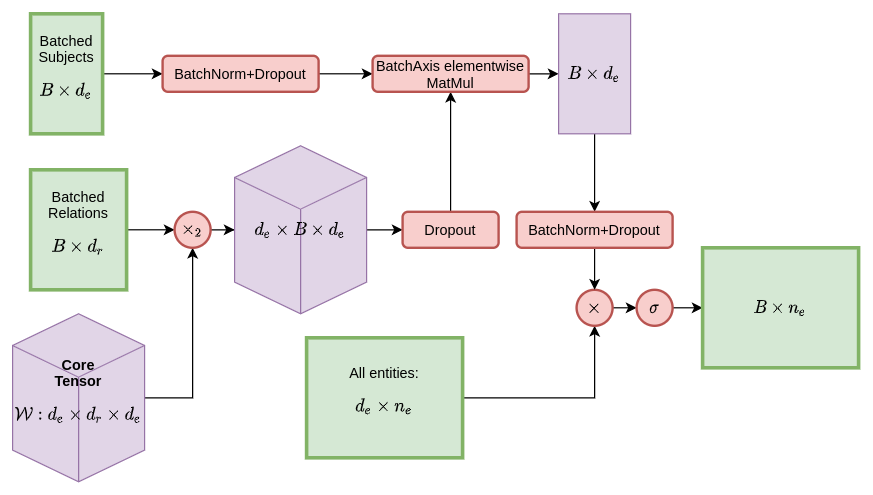This is a project attempting to reproduce the results of the paper TuckER: Tensor Factorization for Knowledge Graph Completion by Balažević, Allen and Hospedales as part of the Advanced Topics in Machine Learning course at the University of Oxford.
 Graphical overview of the system
Graphical overview of the system
The code requires some external libraries, most notably PyTorch.
This class fully supports batching.
tucker = TuckER(num_entities, num_relations, initial_tensor, gradient_mask=None)initial_tensor is what the core_tensor is initialized with. The gradient_mask entry must have the same shape as the initial_tensor. For most purposes, the user may leave the gradient_mask attribute as None. In such cases, it is initialized to a tensor of ones with the same shape as initial_tensor.
Example:
tucker = TuckER(9, 9, np.random.normal(size=[3, 11, 3]).astype(np.float32), np.ones([3, 11, 3]).astype(np.float32))
output = tucker([0, 1], [5, 2])
print(output)produces
tensor([[1.3786e-02, 9.9045e-01, 2.6718e-02, 1.1845e-01, 7.9078e-01, 9.9812e-01,
1.0000e+00, 4.2361e-03, 9.6301e-01],
[9.9839e-01, 9.8582e-01, 1.3405e-05, 9.2480e-01, 9.9501e-01, 9.8919e-01,
9.9992e-01, 4.7132e-01, 1.4876e-03]], grad_fn=<SigmoidBackward>)To run training locally with default parameters, use the prepared shell scripts:
cd training_scripts
./train_<DATASET>.shAlternatively, can use the training script to specify your own parameters.
Open a new session with a GPU and then perform
!git clone https://github.com/sharan-dce/tucker.git
%cd training_scripts
!./train_<DATASET>.sh
Here is where gradient_mask comes in. Whichever values in the core_tensor should not be modified should have an entry of 0 in the gradient_mask and other values should be 1.
DistMult model can be called directly using the TuckER class. The calling approach is as follows:
ini_tensor = np.zeros((4, 4, 4)) # (d_e, d_e, d_e)
ini_tensor[np.diag_indices(ini_tensor.shape[0], ndim=3)] = 1 # superdiagonal with 1s
model = TuckER(9, 9, ini_tensor, np.zeros_like(ini_tensor).astype(np.float32))
output = model([0, 1], [5, 2])RESCAL model actually has no relation embedding so we implement a RESCAL class that inherits from TuckER instead of using TuckER directly.
model = RESCAL(7, 8, np.random.normal(size=[3, 8, 3]).astype(np.float32))
output = model([0, 1], [0, 1])See the docs to find more information about the project, our findings, results and extensions to the work done by the authors of the original paper.